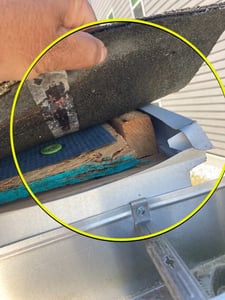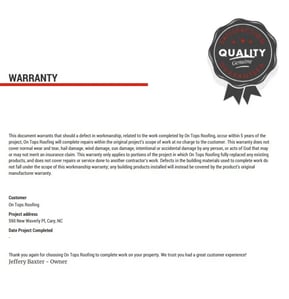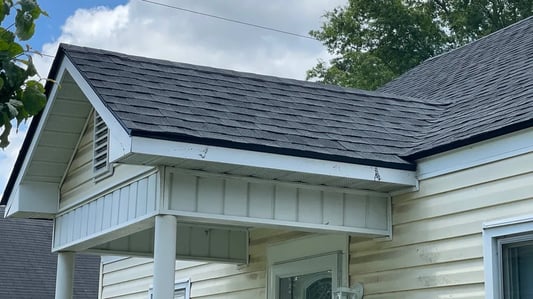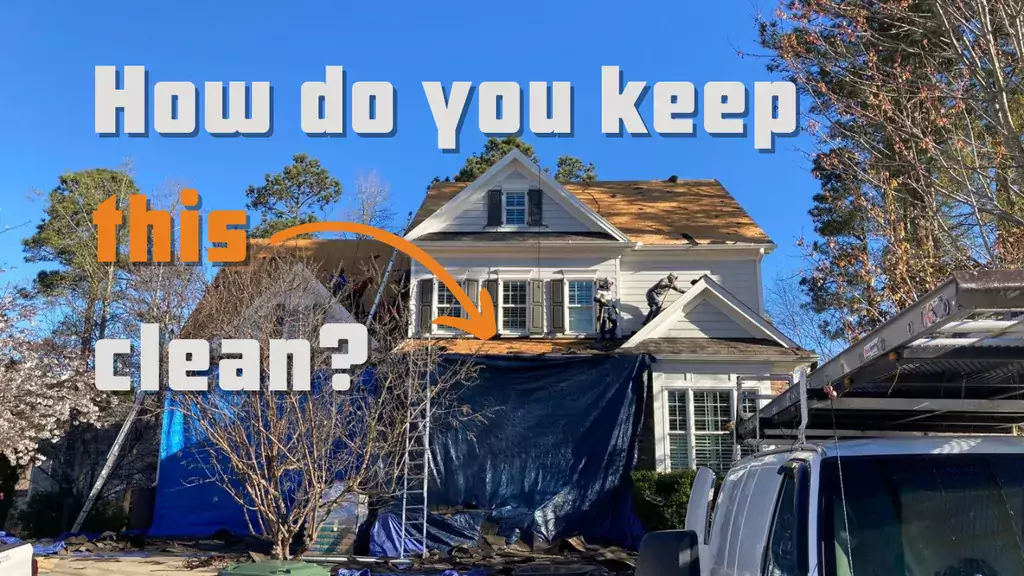The Best Durham Roofing Companies (Durham NC)
Durham, and the surrounding towns in Durham County, have loads of roofing companies that serve the area. Not only are there several companies located...
Whether it's due to natural disasters, severe weather, or simply the passage of time, the day will come when your roof needs replacement. Roof replacement projects are akin to remodeling endeavors in your kitchen or bathroom, involving a carefully orchestrated timeline to minimize disruptions to your daily routine and schedule. This meticulous process extends beyond the roof installation itself and encompasses several essential steps to ensure the project's successful completion.
With nearly 1,000 roof projects under our belt each year, we understand the importance of addressing homeowners' frequently asked question: "What should I expect after my roof replacement is finished?" Committed to ensuring our customers' satisfaction, we'll now outline the five key steps that you and your roofing contractor will take to bring your replacement project to its conclusion.
They are:
Let’s get started!
A new roof represents a significant undertaking, and even after the installation is complete, there's one crucial step remaining: clean-up. This phase is of paramount importance, as it ensures that your property is returned to its pristine state. It's imperative to collaborate with a roofing company that approaches clean-up with meticulous care.
Following the roof installation, your dedicated crew will employ powerful backpack blowers to clear your roof of any debris or residual granules that may have dislodged from the shingles during the replacement process.
To address loose debris and nails, your gutters and window seals will either be meticulously cleaned by hand or via the use of a leaf blower. While every effort is made to remove stray nails, it's possible that one might go unnoticed, particularly if it's directed down a downspout that hasn't been cleared during the initial clean-up. Homeowners are often advised to monitor downspout areas during the first few rainfalls to ensure any stray nails don't end up in their driveways.
The culmination of the roof replacement process involves a post-inspection. During this phase, your roofing contractor will conduct a comprehensive examination of your yard and landscaping to identify any debris that may have been overlooked during the initial clean-up.
Your roofing professional will take meticulous steps to ensure your yard and driveway are free of loose nails. This includes a thorough sweep of your property using two different types of magnets. A handheld magnet is employed in areas around shrubbery and flower beds, while a larger, roller magnet on wheels is used along the perimeter of your home to guarantee the complete removal of stray nails.
To expedite this search and minimize inconvenience, it's advisable to trim your grass short before the replacement project commences. Additionally, if you have a sprinkler system, it's recommended to deactivate it at least two days before the replacement to prevent a soggy yard.
This meticulous clean-up process ensures that your property is not only protected during the replacement but also meticulously restored to its original condition once the roofing project is complete.
A critical step in the roofing process is the final inspection, conducted by the project manager once your replacement is fully completed. This comprehensive assessment serves as the last checkpoint to ensure that your new roof has been installed correctly and that all aspects outlined in your contract have been executed to your satisfaction.
The project manager will oversee the cleaning of your driveway to eliminate any remaining debris, ensuring that your property maintains its cleanliness and aesthetic appeal.
A thorough check of your gutters will be conducted to identify and remove any lingering nails or leftover debris, preventing potential drainage issues or damage.
The project manager will verify that the shingles along the gable line are properly aligned and straight, maintaining the visual integrity of your roof.
If drip edge has been installed along the gable line, its alignment will also be scrutinized to ensure a straight and precise fit.
Any siding that may have been marked or stained by shingles during the installation process will be cleaned to restore its original appearance.
The project manager will take the time to address any remaining questions or concerns you may have regarding your roof replacement, ensuring that you are fully informed and satisfied with the project's outcome.
It's important to note that the final inspection may occur a few days after the roof installation to allow for a thorough evaluation and to ensure that all aspects of the replacement meet the highest standards of quality and craftsmanship. This meticulous approach guarantees that your new roof not only functions flawlessly but also enhances the overall aesthetics of your home.
Maintaining clear and well-documented terms in your contract is essential to ensure that both you and your roofing contractor are on the same page regarding payment details and project timelines.
Typically, roofing contractors may request a deposit ranging from 10% to 30% of the total project cost before commencing work. This deposit is intended to cover the initial expenses related to materials, labor, and necessary equipment. However, if a deposit was not requested, you should be prepared to settle the payment after the final inspection.
Your contract should outline specific payment milestones, including the deposit, progress payments, and the final payment. These details should align with project timelines and the achievement of key project milestones.
Once the roof installation is fully completed, it's advisable to inspect the work performed by your roofer before releasing the final payment. During this inspection, you should look for several indicators of a job well done, such as:
By adhering to the terms outlined in your contract and conducting a thorough inspection, you can ensure that the roofing project meets your expectations and standards of quality before making the final payment. This approach promotes transparency, accountability, and your satisfaction with the completed work.
While not always mandatory by the manufacturer, it is highly advisable to register your roof warranty for manufacturer's defects and wind coverage following your roof replacement. This registration process is critical to ensuring that you have the necessary documentation to support any future warranty claims. Failure to register your roof or losing your final invoice and contract detailing the installation date and shingle type could result in denied warranty claims.
Manufacturer's warranties typically cover defects in materials and workmanship. To safeguard your entitlement to these protections, complete the warranty registration process with the manufacturer. This often requires providing essential information about your roof, including installation details.
Enhanced warranties, which offer extended coverage beyond the manufacturer's standard warranty, often necessitate registration. However, in most cases, your certified roofing contractor will handle this registration on your behalf. If you've purchased an enhanced warranty through a certified contractor and haven't received a copy of your warranty and registration within 60 days of installation, it's advisable to contact the manufacturer
By double-checking and confirming that all warranty registration requirements have been fulfilled, you can proactively avoid potential complications associated with non-registration if you need to file a warranty claim in the future. A registered warranty serves as a valuable safeguard for your investment, providing peace of mind and protection for your roof.
Maintaining your roof's condition is essential to ensure its long-term performance and safeguard your home. Regular roof maintenance involves periodic inspections of vulnerable areas to detect and address potential issues, thereby preventing roofing problems and maintaining the safety of your home.
Roof maintenance tasks, including cleaning gutters, trimming trees, and inspecting your attic for signs of water damage, should be conducted twice a year. Keeping your roof free of leaves, pine straw, and debris is vital as these materials can obstruct water flow and potentially lead to leaks. Homeowners who are comfortable with ladder use and have homes with a height of less than two stories can often perform these tasks independently.
If you're unable to perform roof maintenance tasks on your own, or simply prefer professional assistance, you can hire a roofing expert to help. Refer to our article for additional self-maintenance tips that can aid in preserving your roof's functionality for years to come.
Even with a routine maintenance regimen, it's advisable to have your roof professionally inspected at least once every two years. Professional roofers are trained to identify hidden issues that may go unnoticed during routine maintenance. They'll look for problems such as curling or blistering shingles, popped nails, cracked caulking, damaged flashing, and more. This proactive approach helps prevent further roof damage and ensures the continued safety and integrity of your roof.
By adhering to a regular maintenance routine and enlisting professional assistance as needed, you can extend the lifespan of your roof and minimize the risk of unexpected roofing problems, ultimately preserving the security and functionality of your home.
While every roofer may have different final steps for finishing up your replacement, they’re all designed to ensure that your new roof is left in better condition than before their work began. You should feel confident in your roofers’ ability to give you a job well done both during and after your replacement. If you don’t, it may be time to reconsider your contractor.
One of the best ways to ensure high-quality roofing service is to hire a seasoned contractor. With years of experience helping homeowners just like you, their methods have been fine-tuned to leave customers fully satisfied with their replacement after the job is done.
On Tops Roofing has been working with Raleigh, NC area homeowners for their roof replacement projects since 1991! Whatever your roof requires, We're on it!

Durham, and the surrounding towns in Durham County, have loads of roofing companies that serve the area. Not only are there several companies located...

Roofing projects are messy.

Starting a roof replacement project is a pretty big undertaking. It requires stripping your home of something designed to protect it, and trusting...